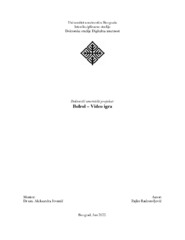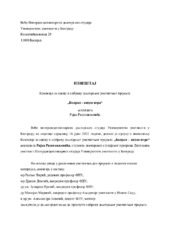| dc.contributor.advisor | Јованић, Александра | |
| dc.contributor.other | Димчић, Драган | |
| dc.contributor.other | Протић, Јулијана | |
| dc.contributor.other | Маравић, Манојло | |
| dc.contributor.other | Ћирић, Растко | |
| dc.creator | Радосављевић, Рајко | |
| dc.date.accessioned | 2022-08-05T08:50:07Z | |
| dc.date.available | 2022-08-05T08:50:07Z | |
| dc.date.issued | 2022-10-18 | |
| dc.date.submitted | 2022-08-05 | |
| dc.identifier.uri | http://eteze.arts.bg.ac.rs/handle/123456789/576 | |
| dc.description.abstract | Doktorski umetnički projekat je nastavak višegodišnjih promišljanja i istraživanja iz oblasti primenjene grafike, animacije, ilustracije, kompjuterskog trodimenzonalnog modelovanja i multimedije. Istraživanjima iz obasti digitalnih interaktivnih medija sam sam se bavio tokom studija na faklutetima, na poslu, ali i privatno. Ultimativni cilj kome sam težio je da napravim video igru, stoga su se interesovanja usmeravala ka pripovedanju interaktivnih priča i rebusa. Video igra je u mojim istraživanjima tretirana kao interaktivna pojava u kojoj igrač-gledalac savladava probleme i dolazi do cilja/saznanja.
Predmet doktorskog umetničkog istraživanja su prostor, interaktivnost i naracija u video igrama koji doprinose stvaranju pojma „igrivost“ (eng. Gameplay). Tok video igre kao i sama igrivost zavise od animacije, koja je u ovom slučaju komponenta koja povezuje prostor, interakciju i naraciju u jednu koherentnu celinu. Igrivost je nova reč, koja ima za cilj da objasni novi parametar, ili kvalitet u digitalnoj umetnosti koji su u užem tehničkom smislu u video igru uneli interaktivnost i promenljivi narativ. Možda se to, uslovno rečeno, može posmatrati kao paralela sa „gledljivošću“ u video i filmskoj umentosti ili „slušljivošću“ u muzičkoj kompoziciji. Na neki način ove reči opisuju prijatnost i kvalitet doživljaja, što važi i za „igrivost“ uz dodatak da se ovde pored prijatnosti i kvaliteta doživljaja opisuju i sposobnost i veštine igrača.
Zbog različitih faktora veština koje ležerne igre zahtevaju tokom igranja kao na primer: brzina, tačnost, preciznost ili snalažljivost, ova vrsta igara itekako može biti frustrirajuća za igrača. Ove video igre postavljaju zadatke. Ako te zadatke igrač ne ispuni, on biva kažnjen. Iako se kazna odnosi na protagonistu u igri, igrač se poistovećuje sa glavnim likom i time doživljava sopstveno iskustvo. Igrivost video igara u sebi sadrži mnoge neuspehe igrača, i ti igrači se ipak stalno vraćaju samom igranju čak i ako ih neki deo igre frustrira. Džesper Džul (eng. Jesper Juul) se bavi ovim paradoksom neuspeha u video igrama kao i samom igrivošću. Posmatrajući ekspresije na licu igrača tokom igranja, on dolazi do zaključka da retko imaju osmeh na licu. Uglavnom su to grimase sučeljavanja sa problemom koje ponekad izgledaju kao agonija, bol, iznenađenje, isčekivanje, konstantna unutrašnja borba, dok su trenutci ispunjenja, sreće i radosti ređi ali intenzivniji.U ovom radu su opisane tri komponente od kojih se sastoji pojam igrivost, a to su: prostor, interakcija i naracija. Kontekst u kome su prezentovane ove tri komponente je video igra koja je osmišljena kao jedna vrsta dizajniranog sveta u kome će se odvijati narativni zaplet kroz interaktivni sadržaj. Osnovni faktor igranja je istraživački faktor koji predvodi splet osećanja prilikom samog igranja, i ukoliko je on sveprisutan do samog kraja naracije, igrači će se vraćati igranju video igre. Tokom igranja igrači nekada nailaze na frustrirajuće delove, negativna iskustva, ali se ipak vraćaju video igri zbog njene „igrivosti“. | en |
| dc.description.abstract | This doctoral art project is a continuation of research in the field of applied graphics, animation, illustration, computer three-dimensional modeling and multimedia. I was researching the field of digital interactive media during studies at faculties, at work and also privately. The ultimate goal I aspired to acheeve, was to make a video game. Therefore, my interests were directed towards telling interactive stories and developing interesting puzzles. In my research, video game has been treated as an interactive phenomenon in which the player / viewer overcomes problems and reaches the goal / knowledge.
The subject of this doctoral art research is space, interactivity and narration in video games that contribute to the creation of the concept of "gameplay". The flow of the game as well as the gameplay itself is dependent on the animation, which in this case is a component that connects space, interaction and narration into one coherent whole. Gameplay is a new word, which aims to explain a new parameter, or quality in digital art. In a narrower technical sense word „playfulness“ has introduced interactivity and changeable narrative into the video game. Perhaps, conditionally speaking, this can be seen as a parallel with "watchable" in video and film art or "audible" in musical composition. In a way, these words describe the pleasantness and quality of the experience, which also applies to "playfulness", with the addition that playfulness more closely describes abilities and skills of the players.
Due to the various skills that player must have, „casual games“ usualy requires: speed, accuracy, precision or resourcefulness. These type of games can be very frustrating for players because they set tasks. If the player does not fulfill these tasks, he will be punished. Although the punishment refers to the protagonist in the game, the player identifies with the main character and thus, player is having his own experience. The gameplay fulfilment or „playfulness“ of video game, contains players failure. Even if these players felt uncofortable and some part of the game frustrates them, they still keep coming back to the game itself. Jesper Juul deals with this paradox of video game failure as well as gameplay itself. Observing the expressions on the player's face during the game, he comes to the conclusion that they rarely have a smile on their face. Mostly these are grimaces of confrontation with a problem that sometimes seem like agony, pain, surprise,anticipation, constant inner struggle, while moments of fulfillment, happiness and joy are rarer but more intense.
This paper describes three components that make up the concept of playfulness, namely: space, interactivity and narrative. The context in which these three components are presented is a video game that is designed as a world, in which the narrative-plot will take place through interactive content. The basic factor of play is the curiosity that leads the web of feelings during the game itself, and if it is ubiquitous until the very end of the narrative, players will return to play or replay the video game. During the game, players sometimes encounter frustrating parts, negative experiences, but still return to the video game because of its "gameplay". | en |
| dc.language.iso | sc | en |
| dc.publisher | Универзитет уметности у Београду, Интердисциплинарне студије Универзитета уметности | sr |
| dc.source | Интердисциплинарне студије Универзитета уметности | sr |
| dc.title | Болрол – Видео игра | en |
| dc.type | other | en |
| dcterms.abstract | Jovanić, Aleksandra; Protić, Julijana; Maravić, Manojlo; Dimčić, Dragan; Ćirić, Rastko; Radosavljević, Rajko; Bolrol – Video igra; | |


